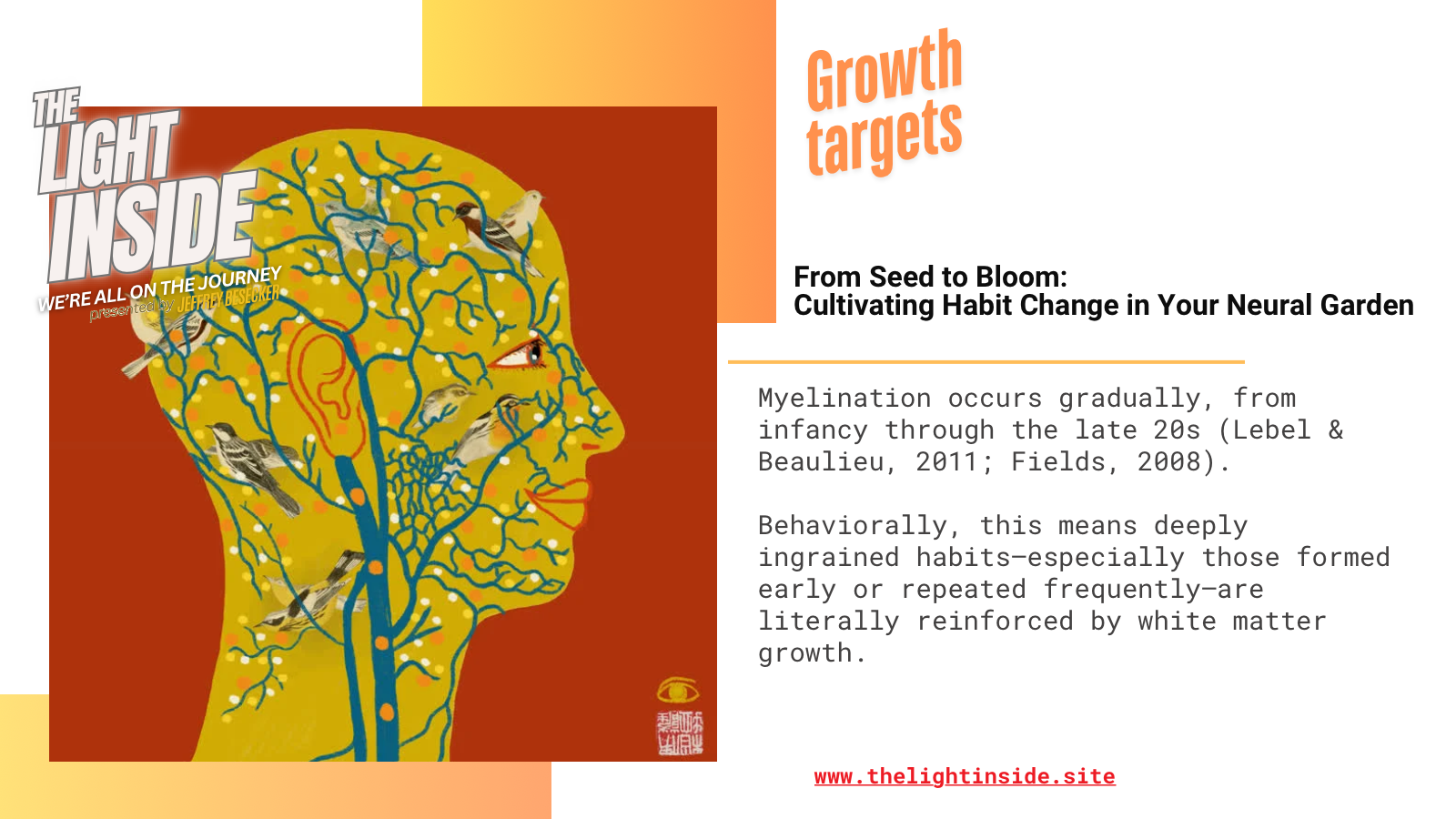From Seed to Bloom: Cultivating Habit Change in Your Neural Garden

Maybe you’ve seen the ads—or read it in books—instantly ‘rewire’ the brain and change habits?
The idea that we can “change recursive habits and rewire the brain instantly” is neuroscientifically inaccurate when examined through the lens of neural imprinting, myelination, and empirically observed neuroplastic timelines.
Here’s how the science breaks this down:
1. Neural Imprinting: Formation of Behavioral Pathways
Neural imprinting refers to the encoding of behavioral, emotional, and cognitive patterns through repeated neural firing.
Hebbian learning—“neurons that fire together wire together” (Hebb, 1949)—establishes these imprints over time and repetition, not instantly.
Empirical evidence: Functional MRI and DTI studies (May, 2011; Kolb & Gibb, 2011) show that habitual neural imprints become entrenched via sustained activation and synaptic consolidation, involving both glutamatergic and dopaminergic reinforcement loops.
Once encoded, these circuits gain metabolic and structural stability through myelination, which reinforces their speed and efficiency—making them feel “automatic” as we engage default neural programming.
2. Myelination: The Biological “Lock-In”
Myelin sheaths, built by oligodendrocytes, insulate axons and accelerate signal transmission.
Myelination occurs gradually, from infancy through the late 20s (Lebel & Beaulieu, 2011; Fields, 2008).
Behaviorally, this means deeply ingrained habits—especially those formed early or repeated frequently—are literally reinforced by white matter growth.
The metaphorical ‘rewiring’ of such circuits requires demonstrable remyelination and axonal remodeling, processes that unfold over weeks to months, even under ideal neuroplastic conditions.
3. Neuroplasticity and Behavior Change Timelines
While neural networks can begin shifting within hours to days of new learning, full structural change takes considerably longer:
- Short-term neurochemical changes (dopamine, glutamate, BDNF) → minutes to hours.
- Synaptic remodeling and gray matter density changes → weeks (Draganski et al., 2004).
- Myelin adaptation and long-term consolidation → months to years (Fields, 2015).
This aligns with findings from habit-formation studies (Lally et al., 2010), which show new habits stabilize after an average of 66 days of consistent repetition.
4. Why Instant Rewiring Is a Myth
The “instant change” narrative oversimplifies:
Myelination is a slow, contextual, and experience-dependent process; axonal insulation can’t be restructured in moments.
Neural imprinting resists rapid change because the brain favors metabolic efficiency—it keeps what works until sustained new input proves otherwise.
Psychological and somatic factors—stress regulation, emotional safety, attachment patterns—determine how effectively new pathways consolidate.
In effect, you can initiate or ‘trigger’ new myelination instantly (through awareness, intention, or corrective experience), but embodying the change is a progressive biological process. The process itself being more emergent—a metaphorically germination or booming—rather than ‘wiring’.
5. Lifespan Perspective: Evolution of Modulation

Conclusion
- Behavior change is biologically incremental.
- Neural imprinting lays down pathways through repetition.
2. Myelination reinforces these as default modes of functioning.
3. New, adaptive behaviors require sustained activation and emotional coherence to recruit myelination and synaptic reorganization.
So, while insight or awareness can spark the beginning of change instantly, embodied reintegration unfolds over weeks to months, guided by neuroplastic principles rather than quick fixes—with lasting change being an adaptive process across our lifespan.
“The Blooming Brain” — A Neural Garden Metaphor
Changing a deeply rooted habit isn’t like flipping a switch; it’s like a flower slowly unfurling in sunlight.
In the earliest moment of awareness—a new intention, insight, or corrective emotional experience—a seed is planted in the neural soil of your mind.
This isn’t yet a bloom. It’s a delicate imprint, a signal to your nervous system that something new is being asked of it. In neurobiological terms, this is the initial spark of synaptic activity, the beginning of a new pathway being traced.
As sunlight (focused attention), water (consistent repetition), and nutrient-rich soil (emotional safety) nurture the seed, the roots extend deeper, anchoring this pattern within your neural architecture.
Myelination—the brain’s way of wrapping these neural “stems” with insulation—doesn’t happen instantly. Just as no flower blooms overnight, the brain strengthens pathways gradually, insulating them through repeated activation and emotionally coherent experiences.
Over days and weeks, the first shoots emerge—small behavioral shifts, early moments of resilience, a growing capacity to choose differently. With each repetition, more myelin builds, making the new behavior faster and more efficient—just as a stem grows stronger with each inch toward the sun.
And then, with patience, the flower unfolds. The bloom isn’t a single event but the visible expression of a long, unseen process beneath the surface—one that required time, regulation, and nourishment.
Similarly, lasting behavioral change reflects not a sudden rewiring but a biological unfolding of new neural pathways and the dying off or pruning back of old ones—oftentimes, the two remain co-existent for mutual comparison via affective forecasting.
Key takeaway:
- Awareness plants the seed.
- Repetition, regulation, and emotional safety nurture the roots.
- Myelination strengthens the stem.
Habit change blooms through sustained care, not quick fixes.
Coachable Reflection Prompt:
“If this change in me is a flower, what kind of daily sunlight and water—what consistent, nourishing actions—would help it bloom in its own time?”


